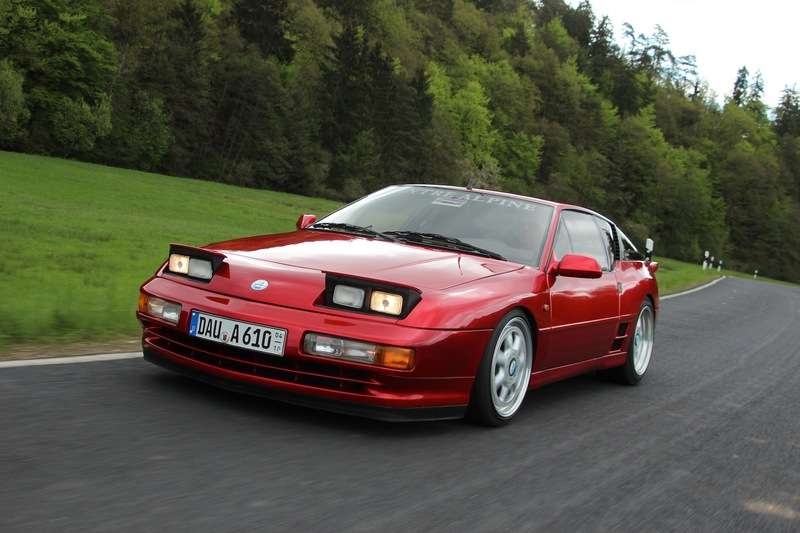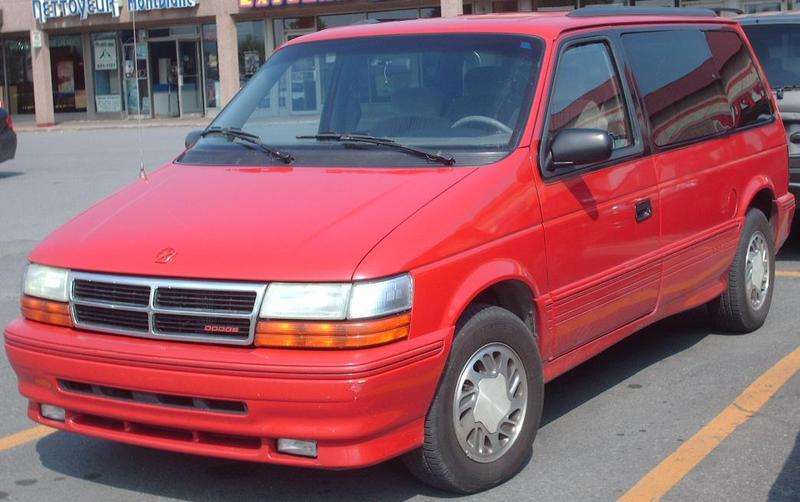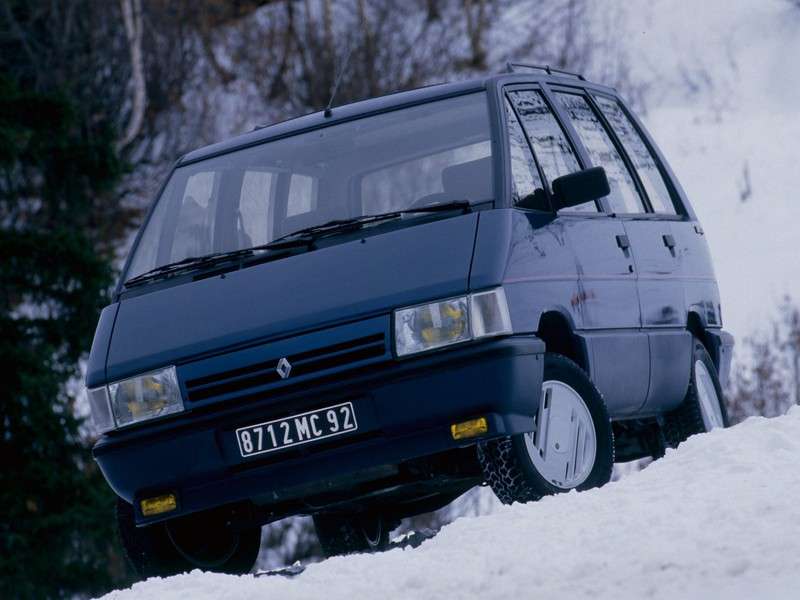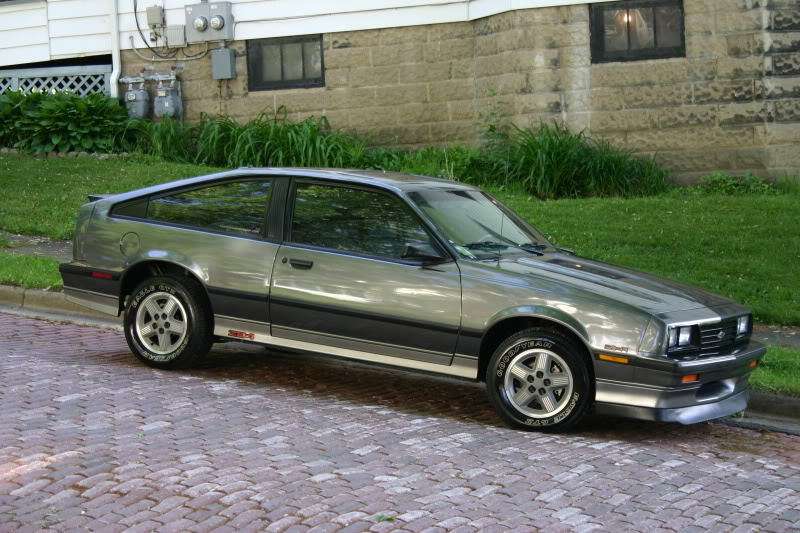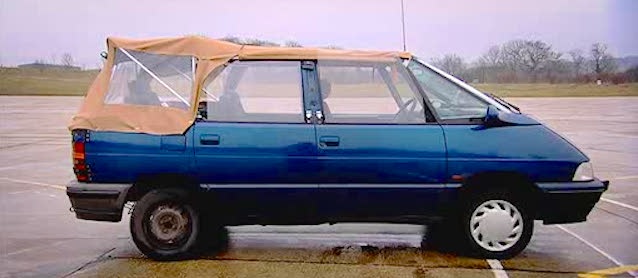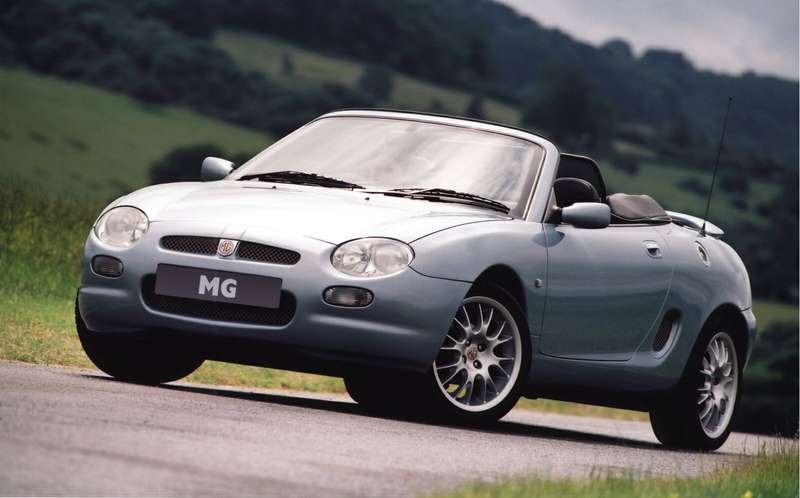Part 6 - New People, New Times and New Cars
With the blockbuster launches of 1981, and the strikes of 1981-82 having stunned America and having had an effect on the nation's politics, the 1980s headed into a decadent time.
For starters, the strikes in 1981 ended with the unions getting their way and the professional air traffic controllers getting re-hired, a backdown that was hugely embarrassing for President Reagan - but one which showed that he and the Democrats could work together. Having succeeded at stopping what they viewed as an unjust firing, the unions headed out against other injustices, but found a surprise waiting for them which was due to be their minefield, namely that Walter Reuther's statements in the late 1970s that labor and management could find a way to coexist were starting to come true.
A new generation of workers was entering the workplace in America, the baby boomers moving into positions of power and influence. They came in having a strong desire to better themselves, but this generation was also smart enough to see that they needed to all be better off if they themselves were to benefit. This led to the confidence of the times being matched in aggressive actions to expand both America's wealth and the prosperity of its working classes, figuring that if the working people prospered than so would the management classes. These people were legion in Detroit by the middle of the 1980s, and while the men on top were still heavily suspicious of the UAW's motives and the UAW was suspicious of the company and its bargainers, the middle levels of management were soon full of those who saw the UAW as a potential asset. This led to many actions by all of the makers to improve the quality of work life for the employees.
"
When I first walked into River Rouge (the famed Ford assembly plant in Dearborn, Michigan), I went to see one of the plant managers, wanting to tell him about the Quality of Job One and Our Company is Our People plans. I found him in the middle of the plant screaming at an employee over having to use the bathroom. The man looked ill to me, and yet this man wasn't even thinking of it. I demanded he stop yelling at him, to which he turned to me and said 'another blankety-blank accountant'. I put my hand on the guy's shoulder and said 'son, you know why we need programs to make our people's lives better? That. Right there.' I could see he was sick, and I told him to go home. When the plant manager protested, he said 'are you serious?' to which I answered 'well, I don't know whether you take it seriously, but as far as I can tell, I'm serious.' That went around Rouge in about a New York Minute, and I never had trouble there again." -- Former President of Ford Motor Company, Donald Petersen, speaking in The American Auto Factory, 2006
"
Guys were hearing about the new plants at Bowling Green and Tacoma and the rebuilt plants at Baltimore and South Gate and Janesville and asking 'why can't we get all of that stuff?' When I asked GM management about that in 1982, I was given an answer 'We haven't gotten to all of the plants, yet.' I responded to that by asking 'so, all of GM's plants are gonna get all of that?' I must admit I was stunned when the guys at GM said 'Yes.' I didn't think they were willing to spend the money. But by the end of the eighties, they had kept their word. I hated to admit it, but it was true. The guys were working in better plants, and they made better cars as a result. We went into the eighties wanting to hate on another. By the end of the eighties, they were listening to us for real. By the end of the nineties, they were raising up ideas to help us. It was stunning to me, but I had to re-evaluate everything I had ever thought about Detroit." -- Former UAW President Douglas Fraser, In an Interview with the Detroit Free Press, May 2004
"
If the 1970s had been the low point in the relationship between the UAW and the Big Four, then the 1980s were where their ultimate victory began to become a reality. The UAW had been trying to make themselves heard in the management of the company since the sit-down strikes in Flint and the strikes of the post-war years, but the responses had always been bribery. But Romney and Reuther and the concessions the UAW made to keep Chrysler alive and Chrysler's subsequent commitments to those who lost their jobs as a result of its reorganization was a sign of what was to come, but it was not the destruction of the unions as many feared....but rather it was the start of where unions began to take an active interest in the companies that employed them, and that more or less began the end of the adversarial bargaining that had dominated American labor's relations with the corporate leaders they worked with. It took a while for everyone to get the message, but eventually they did, and everyone benefitted from it." -- Casey Rutledge, Rivers of Steel, 2015
The result of this 1980s push was political changes, too - so much so that when Fraser began his push to get universal health care in the United States in 1983, he had little trouble getting it, and his vocal opposition to the bitter Arizona Copper Mine strikes of 1983 gave much support to the miners, to the point that the copper miners got most of what they wanted and would end up heading back to work. Labor's strikes had raised their concerns, and the decisions of the American managerial class in the 1980s meant that it would not be a long time before things changed in America. The United States in the 1980s moved to a much more confrontational position with the Soviet Union and states they disagreed with, and while Ronald Reagan's loss to Ted Kennedy and Henry M. Jackson in the 1984 Presidential election changed a great many things, it did not change the strong-arm foreign policy and it did not change major economic policies. It did, however, have a huge change for the automakers in 1986, when President Kennedy passed the "Advancement of American Health Care Act" in May 1986, which opened up the Medicare Program to those who wished to buy in and enacted substantial legislation to control the industry to ensure affordable healthcare for all Americans - and the ability to buy into Medicare made sure that the insurance companies paid attention.
To nobody's surprise, being both huge industries that were heavily unionized, the American automakers were among the first one to feel the changes - and it was a godsend. All of the Detroit makers by then were seeing the old guard of the post-war era retire in numbers, and the reduction in health care costs for them saved them billions in health care costs. Chrysler's survival had in large part come from the UAW being willing to deal with Chrysler, and the middle management made sure that the automakers paid back the guys who had given up concessions to help keep the business alive - for example, when Chrysler had started selling the Peugeot 205 in North America, Chrysler reactivated its long-mothballed plant in Hamtramck, Michigan, to make it in North America - much to Peugeot's initial unhappiness, who wanted its plants in France to supply the cars. Despite the acrimonious relationship between GM President Roger Smith and Fraser, particularly after Smith and many of his board of directors voted themselves multi-million-dollar bonuses hours after extracting billions in wage concessions from the UAW (An act that ultimately saw Smith fired), after the rocky 1973-81 period, labor peace was the rule in Detroit, and the vehicles they built improved steadily in quality from an already good standard. Douglas Fraser's appointment to Chrysler's board in 1979 was a sign of the future, as when Fraser retired from the UAW in 1984 his successor, Owen Bieber, was appointed to fill his seat, and Bieber's number-two, Raymond Majerus, was appointed to the board at American Motors in 1985. (When Majerus died of a heart attack in December 1987, his protege, Devon Mitchell, took over Majerus' seat on the board at AMC, appointed at the same time as famed car dealer Ivan Vassall Sr, giving AMC two black board members and a bit of a news event at the time.) After Henry Ford II's retirement from Ford in 1980, Philip Caldwell (who had been working for Ford since 1953) succeeded him, and Caldwell and his successor, Donald Petersen, were instrumental in the company's huge shift in labor relations in the 1980s.
In the middle of this, the imports began setting up in North America. Nissan began operations in Smyrna, Tennessee, in 1982, followed a year later by Honda in Marysville, Ohio and in 1984 by Volkswagen in Westmoreland, Pennsylvania. It was something of a surprise to the Japanese that the plants in the United States had workers that were just as diligent as their Japanese counterparts, and even more to their surprise, they were rather more co-operative. The UAW attempted to unionize both Japanese facilities and failed, though they succeeded in unionizing the Volkswagen plant in Pennsylvania in 1985 - with Volkswagen, whose German boards have half labor representation, openly approving of the UAW's efforts. Honda by the 1990s would go so far as to import cars into Japan from the United States for a while.
The Detroit automakers rolled through the 1980s developing better and better designs. General Motors' Quad-Four engine design spawned a second new engine, the Future One Engine, a V6 engine family of 2.8 to 4.4 liters that would be used in a variety of applications from mid-sized sedans to pickup trucks, with the Power-Six debuting on the Chevrolet Celebrity, Pontiac 6000 and Buick Regal in 1984, as the new A-bodies complemented the successful J-body cars of three years earlier. The following year, GM's Future One . The engine was also soon used in a variety of cars from all GM divisions, as well as the Chevrolet S-10/GMC Sonoma pickups and the Chevrolet Astro/GMC Safari minivans. The A-bodies themselves were quality units, much better than the X-bodies, and while the Celebrity was meant as a fairly conventional mid-sized sedan, the Pontiac 6000 was meant as a fun car to rival cars like the BMW 3-Series and the Buick Regal was meant as middle-level luxury car. It did these jobs fairly well, with the 6000 having a 4.0-liter version of the Future One engine and a Getrag-built six-speed manual transmission as standard equipment, which made the 6000 a genuinely quick car. The design of the Future One led to the 'Future Two' V8, which debuted in 4.8-liter form in the 1986 Cadillac Allante, which included all of the 'Northstar System' chassis technologies, which was quite a long list - load-leveling suspension using magnetorheological shock absorbers and progressive-rate springs, traction and stability control, anti-lock brakes and limited-slip differentials, with road-sensing four-wheel-drive being an option that roughly three out of five Allantes came with. Also new to the Allante was the new 5L80 five-speed automatic transmission. Most of these technologies would soon spread to lots of other GM cars. The Future series engines all also included provisions for the displacement on demand technology which GM had first introduced in 1981 - the Cadillac V8-6-4 proved to be an engineering challenge not due to mechanicals, but due to electronics - a problem solved by an unlikely source in Commodore Computers, who developed a special ECU for the system to fit to Cadillac cars. The end result was that provided the engine was maintained properly, the V8-6-4 with its Commodore ECUs was nearly bulletproof. Commodore and Hughes Aerospace both worked for GM extensively, and much of Commodore's technology was bought outright by GM after the company went bankrupt in 1994.
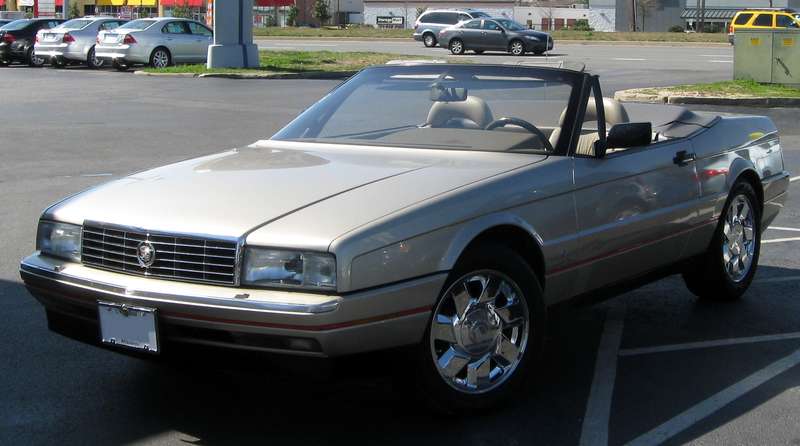
A 1988 Cadillac Allante
"
The V8-6-4 was designed to make a great big engine meet modern fuel efficiency standards, because Cadillac really didn't want to lose its own V8 engine after all it had been for so long. So they started making the V8-6-4. But as soon as the guys on West Grand Boulevard found out what we were up to, they demanded to know why, and once they saw where we were at and the problems we had, Pete [Estes] himself came to see us and asked if other engines could use this. When I told him that I didn't see why they couldn't, he immediately said 'Do what you gotta do to make it work, and we'll sell it.' I didn't think Pete was that kinda guy, but it wasn't long later that I saw what the engineers were doing for the J-bodies and I understood." -- Ed Kennard, Cadillac's General Manager during the development of the V8-6-4, 1994
Ford went even further than GM did in terms of design. Having reeled some from the departure of Hank the Deuce and the fact that many of its boxy design cars of the late 1970s and early 1980s were not strong performers in the marketplace, Ford's design department took the aero design theme to extremes in the 1980s, as well as introducing many new technologies of their own - one particularly notable example was that most 1983 to 1986 Ford Escorts came with the turbocharged 1.6-liter version of the Ford CVH four-cylinder engine, as the turbocharged CVH proved to be smoother-running and more reliable than the original CVH because of lower compression and the turbo counteracting the engine's harmonic imbalance. (While this did concern some customers, turbocharged CVH engines proved to be stout, reliable units.) The Escort's initial styling differences with its European counterparts did prove to be an issue, as many customers were found to find the smoother European-styled car better looking. Recognizing this and aware of GM's new J-body, Ford began selling the Sierra in North America in the summer of 1982, and they went for big money with the Taurus, introduced in 1985.
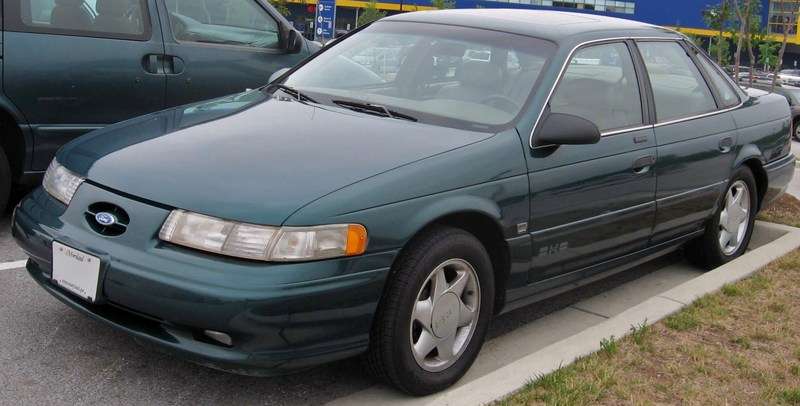
A 1988 Ford Taurus SHO
The Taurus was a gamble of no small proportions, and Ford boss Caldwell had no difficulty admitting that he had staked virtually everything on the Taurus, first seen in Super Bowl advertisements in January 1985 and formally launched to more than a little fanfare at MGM Soundstage's Studio 85 (where Gond With The Wind had been filmed) in March of that year. Dubbed the "Car of the Future" in press releases, the Taurus was meant to be an executive car in Europe and a strong mid-sized contender in North America, and its 'aero-style' design, similar in language to the Escort, Sierra and Thunderbird, was a handsome machine. Designed to handle more like a sports car, Ford touted that they had tuned the suspension of the Taurus in Germany and America, and boasted of many high-speed test runs to see how the car handled at high speeds. Their touting was very proud, but it didn't take long to see why they were cocky. The Taurus used a variety of powerful engines, the king of which was the Taurus SHO's supercharged 3.0-liter V6, designed and built by Yamaha, capable of making 285 horsepower. The Taurus included both a high-quality and luxurious interior, with some neat options available, including one of the first CD players in a car, cellular phone, power seats with power-adjusted lumbar and side support, a high-tech digital dash (an option that most Taurus had) and even an all-glass roof for sedan models, the last an expensive option but one which a fair number of cars had. A radical design, the Taurus was a big gamble for Ford - and one that most at GM and Chrysler figured would fail in favor of more conventional medium-sized sedans.
They would be disappointed, as the Taurus would go on to be a fair success in Europe but a massive one in America. Ford's Vice-President at the time, Donald Petersen, boasted of how he had left his chaffeur-driven Lincoln at home and bought a loaded Taurus to drive himself to work every day. It was soon also frequently used by American embassies in Europe, even some used as staff cars for American armed forces around the world. Indeed the Taurus' replacement of the aging Grenada in Europe proved to be a godsend for the company's lineup there, as the Grenada had by that time largely been limited to production in Germany, which due to the rising value of the German Deutschemark at the time was disproportionally expensive. The Taurus, when combined with the Fiesta, Escort and Sierra, was all the evidence Ford needed that its future lay in the 'Aero-style' cars.
"
One can't be mad at the gamble. Ford decided to step up to the future, and boy did they hit a home run. The Taurus is not merely a good car like the Escort and Sierra, it is a great car. It really is not just a pretty face, it is a massive cut above the competition, a luxury car at a mid-sized price, a machine that is so impressive it defies conventional wisdom. American cars have never better than this, and if this is the future, we love it." -- Motor Trend, stating the rationale for the Taurus being their car of the year for 1986
"
Perhaps the scariest moment for all of us on 'Team Taurus' was the visit in the spring of '84 when Hank the Deuce came to pay a visit. He had retired from Ford by that time, of course, but nobody at Ford ignored him when he listened, period....He had always been a more traditionalist guy when it came to car styling, so when we showed him the Taurus I think all of us who were there had butterflies in the stomach. But Henry just walked into the studio, eyeballed the Taurus sedan and wagon we had readied for him, and smiled broadly. He just breathed deeply and walked around them, a great huge grin growing on his face the more he looked. He had finally walked around the sedan and came back to me, his hand out. He shook my hand with a huge smile on his face, and said to me 'If that's the Ford of the future, my family's company is in good hands.' That didn't just seal that the Taurus was gonna be sold, it also meant that I had designed something that everyone would be talking about for a long time to come. Because if I could get Henry to love it, I don't think there was anybody at Ford who wouldn't." -- Jack Telnack, talking about the Taurus to Motor Trend's 'Legends of Detroit' issue, 2011
GM had a surprise of its own, but in a totally different market, and one which had been pretty lonely for a long time - small sports cars.
The market dominated for decades by the British had effectively been abandoned by them. British Leyland's financial problems in the 1970s and the abysmal build quality of many of the cars had contributed to them becoming rare pieces by the end of that decade, with the Triumph TR7/TR8 departing the American market in 1979 and the MG MGB in 1980. But as the number of people wanting a good small sports car grew in the 1980s, they found a handful of good choices, the most common of which was the Alfa Romeo Spyder. But with Chrysler's sale of the Matra Murena showed that the market was real, and in 1984, both General Motors and Toyota jumped in it with both feet, bringing out the Pontiac Fiero and Toyota MR2. The Fiero, powered by the Quad-Four engine, was the larger and quicker of the two, though they were pretty much even on handling. Both cars were fantastic drivers, and it didn't take many drives in either the 185-horsepower, 30-mpg Fiero or the 125-horsepower, 34-mpg MR2 to win over a convert to the love of driving. Compared to the Murena, the Fiero and MR2 were both quicker, though the Murena was a hoot to drive as well and the looks were totally a matter of taste. And to nobody's surprise, the three spent the 1980s as rivals - and big ones. All three were excellent commuter cars when they weren't out driving fast, and many of the people who bought them would say that they would use these cars to drive to work and do everyday errands that didn't need more than two seats, as well as having great fun when the opportunity presented itself. The Fiero was an instant score for GM, despite some niggling troubles with electrical components and potential engine fires, the Fiero sold extremely well, and GM could loudly say they had a car that nobody else in Detroit had any answer to and not be lying.
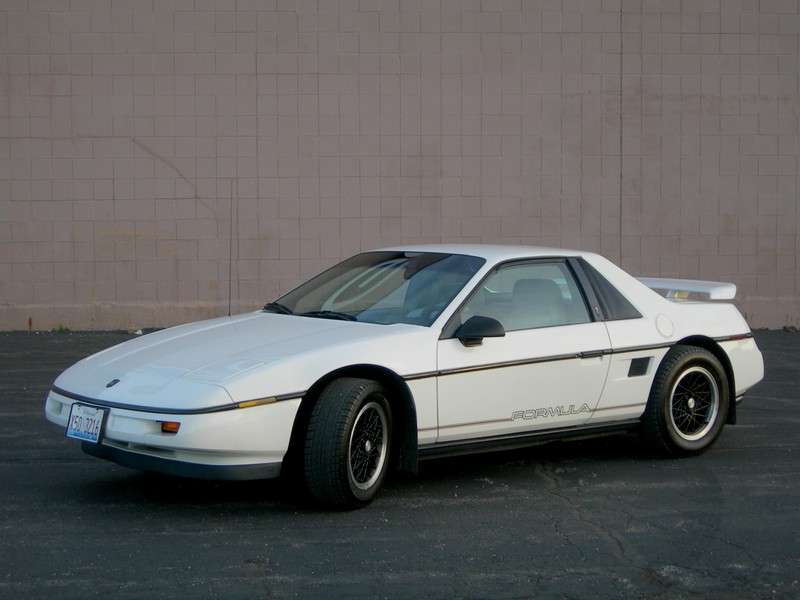
A 1985 Pontiac Fiero Formula
The Fiero would come in the middle of Pontiac's move to become the performance car division of General Motors, and it was a fitting addition to it. The Fiero and MR2 would ultimately go on to be arch-rivals throughout their respective existences, but the 1980s variants are considered to be more pure performance cars than the second-generation versions (this is also widely felt about the MR2 as well), but both cars would see their third-generation versions (built starting in 1999 for the MR2, 2000 for the Fiero) returning to their previous status as performance cars for the masses.
British Leyland's massive problems proved to be an opprtunity for one of America's most famous racing car drivers in Dan Gurney. Having turned his All American Racers team into an equal parts race team and engineering consultancy much in the line of the famed Lotus company in Britain (and having been involved in pretty much every AMC car from the 1967 Javelin onwards), Gurney got an opportunity in 1981 by the not-at-all-hidden desire by the new British government headed by Margaret Thatcher's desire to sell off many portions of British Leyland, which had never turned a profit, and when they started looking to break it up into pieces (despite BL at the time having a promising hookup with Honda underway), Gurney convinced lifelong friend Jim Clark and famed auto dealer Roger Penske to get involved with a plan to buy the pieces of the failing British Leyland and turn it into a new company. Thatcher's government was surprised by this, but Gurney and his partners were serious - and Honda, who wanted desperately for the BL hookup to work in order to improve their position in Europe, was also in favor - and the Falklands War with Argentina in 1982 gave Gurney and his partners time to get the details settled. In November 1982, Gurney presented a plan where he would form a new company known as Gurney Austin Rover, comprising the Austin, Rover, Triumph, Jaguar and Land Rover divisions. Gurney's proposal became a topic of massive political debate during the 1983 British elections, which ended in a decisive victory for Thatcher, and in April 1984, Gurney Austin Rover came into existence.
It didn't take long for the Anglo-American firm to begin making a name for itself. Gurney himself led a deep management team that included many from both sides of the Atlantic, but the early times were extraordinarily difficult. Sir Michael Edwardes' time at BL hadn't really helped matters, as his massive cuts to the workforce and emptying out of divisions was of no help to the new firm. The reintroduction of the Mini to many markets in the 1980s did end up being a help - GAR could, and did, charge a premium price for it in many markets - and the programs with Honda led to many Honda engines being used in BL products. After GAR sold off Jaguar to Ford in 1985 - which in the middle of the coal miners' strike and at a time where huge labor unrest was shaking Britain, caused an uproar - GAR moved Austin into the lower-to-middle end car role, with Rovers being more luxurious cars and Triumph being a sporty car maker, with the edge of this being the introduction of the TS2 (Triumph-Saab) V8 in 1987 in the Saab 9000, with the same engine going into the new Triumph Renown in 1989. The company's list of new cars in the 1980s was impressive (many of these being improved versions of early 1980s BL designs), reviving Triumph as a British BMW and developing the Austin Metro into something rather better over time. By 1990, Gurney Austin Rover was making money and growing its market share in many parts of the world, and the firm was by then also assembling Honda vehicles for European markets. GAR was happy to help Honda in many cases as well - the firm was instrumental in helping the Japanese company stave off a takeover attempt by Mitsubishi in 1992, and the TS2 V8 began to be used in higher-end Honda products starting in 1991 NSX sports car - and one result of this was that GAR and Honda by the 1990s repeatedly collaborated on design and engineering efforts for smaller cars. The MG brand returned with the 1991 MGF, the first mid-engined car from the company which was an immediate rival to the growing numbers of small sports cars meant for enthusiasts.
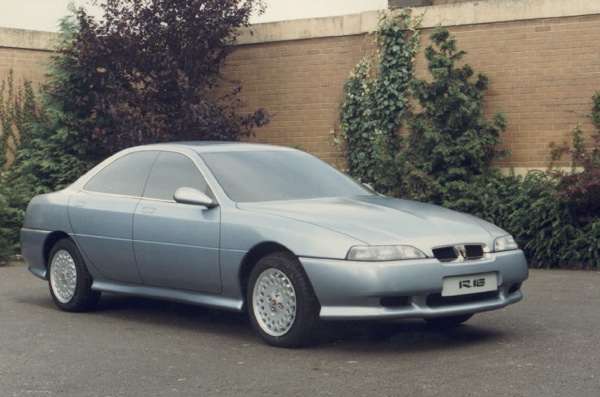
The 1988 Rover R16 concept, which would almost unchanged become the 1990 Rover P7
The 1991 MG MGF sports car
"
Gurney Austin Rover was nothing if not one of the biggest gambles in automotive history. We were supposed to believe that no matter how brilliant Dan Gurney and Jim Clark and Kevin Russman and Roger Penske and Roy Axe and Michael Edwardes and Graham Day unquestionably are, they were going to take on the most mismanaged shithouse of a company in automotive history, a firm where the management was so bad that a damned communist was able to have more power over the company than its management and where they averaged five or six work stoppages a week at one point, out of the hands of a government dominated by hard-shelled capitalists and then turn it into a successful automaker? The thought was insane. But then again, this was Dan Gurney here, he tends to make the impossible possible when it comes to cars....GAR reset itself remarkably quickly, got tons of help from Honda and outside design houses as well as Gurney's own crew and began to turn the firm into a car for enthusiasts. They could do things faster than anybody figured was possible, but this company was above all else run by enthusiasts, and it showed. Austin may have eventually shrank down from the intense competition for small cars, but the Mini, Rover, Triumph and Land Rover never did, and it shows today." -- Peter DeLorenzo on Gurney Austin Rover on his AutoExtremist blog, talking during the company's 30th anniversary in 2014
"
I was initially absolutely stunned at it. Genuinely shocked. British Leyland was a lumbering behemoth, a giant beast of a company with development problems, internal rivalries all over the place, a militant workforce and faced with a market and government that were at best ambivalent or at worst actively malignant. But he was serious, all of the others were serious, and I knew well as everyone that he was in for a ride....I went back there because by the time I did, Gurney had sold Jaguar to fund the redevelopment of everything else, and he had done what he had set out to do there. They were back racing, the workforce had members on the board and was getting a chunk of the profits, plants had been re-opened, Honda was wanting to use the Triumph-Saab V8 and was offering its small engines in return, and they had big plans for everything from people carriers to luxury limousines to supercars. But what got me most was when I went back to see him, his first question to me was 'What can you do for the company, because I don't want anybody here who doesn't have ideas of their own.' Gurney knew I had run the firm in the past, so I knew what he was asking me about was what could I do to make the cars sell better. That told me much, and it was much that I liked." -- Sir Michael Edwardes, on why he returned to Gurney Austin Rover in 1988
The Renault-AMC relationship was fully and completely consecreated by the events of 1986-87. On November 19, 1986, Renault's director Georges Besse, AMC's director Cameron Robertson and AMC's fast-rising star manager Mitt Romney were all shot by Action Directe gunmen as they emerged from a meeting at a restaurant in Paris. Romney was not seriously wounded, but Robertson was left in a wheelchair as a result and Besse died of his wounds despite the best efforts of a number of others, including Romney himself. Within a month, Besse's successor, Raymond Levy, began plans for Renault to divest itself of AMC - a fact that shocked AMC's managers and convinced them to make a last-ditch effort to convince Renault to stay involved. On April 5, 1987, Romney led a delegation to Paris (including design boss Richard Teague, chief engineer Kelly Sinclair and chief powertrain engineer David Johnston) with multiple books of drawings, designs and future operations plans, including detailed financials of what AMC was up to, hoping to convince Levy to continue Besse's plans - indeed, Romney is said to have said to Besse that "If I'm gonna get shot, I'm gonna make sure the people shot me don't get shit from me" - and Romney made it clear that if Renault backed out, AMC's management would make a play to ally with somebody else. Somewhat surprised of the depth of the plans, Levy two days led Romney and his delegation to meet French President Francois Mitterand, to whom he made the same presentations and points, pointing out that Renault had already sank billions of francs into AMC, and that bailing out now would make Renault's involvement to this point largely pointless. Mitterrand agreed. But Romney and the others had another card to play - that being a press presentation to the media in France that AMC would seek to assemble Jeeps in France, stating that AMC would back up Renault's racing programs and offering to repurpose closed Renault facilities for AMC's other heavy industrial facilities. Romney further stunned the Parisian media by conducting his press conference and interviews in excellent French.
Levy ultimately did backpedal on the divestment of AMC, and true to form renault began assembling Jeep Cherokee SUVs and Comanche pickup trucks in France in 1988. Romney's actions paid off for him as well - he was appointed the co-chairman of the AMC board in March 1988, and joined the board at Renault in January 1989. Robertson, despite being left in a wheelchair from the shooting, made a point of being in the courtroom during the trial of the people who had shot him, Romney and Besse, and when asked whether he feared Action-Directe killing him he brushed it off "If I give up what I was wanting to do, they've won. And I am not gonna be beaten that easily." True to form, AMC's engineers were instrumental in the develop of the Renault Clio (which launched in 1989), Megane (launched in 1991) and Twingo (1992), all of which went to be sales successes for the company, while the introduction of the new AMC Ambassador in 1990 (OTL's Eagle Premier), along with the new-for-1991 fifth-generation Javelin, Medallion, Spirit and the Jeep lineup (which included the new-for-1992 Grand Cherokee SUV) made AMC plenty of profits. The company proved good to its word on the racing support as well - Renault's Indycar program was taken over by AMC in 1990, and many Renault-powered Formula One cars in the 1990s carried AMC sponsorship decals, and the company's finances helped get Al Unser Jr. signed on at Williams Grand Prix in 1993. The new engines developed by both firms in the early 1990s for both of their models proved to be excellent units, and Packard's huge 1980s re-do of their lineup proved to be both a sales hit and something of a cash cow for the company.
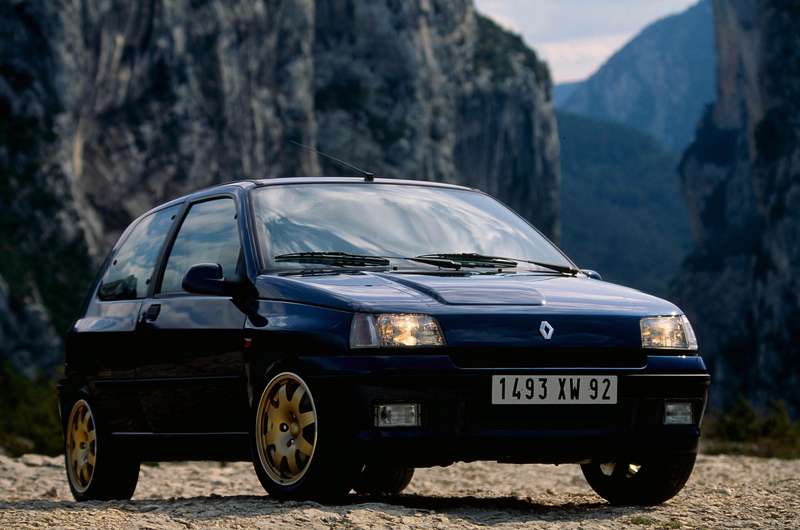
A 1993 Renault Clio Williams 1
None of this was any benefit to Japan's automakers and their decades-long attempts to make conquests in the American car market. In the semi-autobiographical book Made In Japan, Sony's founder and chairman Akio Morita commented in quite a lot of depth about how Japanese culture and their way of thinking, a book that seemed to be about Japan's success in export fields. It drew a response from Lee Iacocca and Mitt Romney, the book Talking Straight, where Romney and Iacocca pointed out that one of the people most influential with Japan's modern auto industry was an American, W. Edwards Deming, who had taught the Japanese much - and many of those lessons had been absorbed in Detroit, too. It was also pointed out that Japan was aggressive in sales tactics and had over the years built extensive trade barriers to its own lucrative domestic markets. Despite the comments, Talking Straight refused to bash Japan in general.
"
The Japanese turned a nation destroyed by war into an economic powerhouse in a generation, as much as their tactics played a role in that, if they had not produced excellent products, they would have never been able to take off to such a degree as they have. They are worthy of respect. But one of the advantages of today's modern world is that they taught us here in Detroit many lessons, and we now know about all of the flaws we had once been guilty of. And now, we produce products to as great if not a greater quality than theirs, and we have no issue with them selling cars in America, quite the contrary. Lee said "If you find a better car, buy it." Mitt said "We want customers to make great choices, because we believe in what we build." That's how American automakers are now, and Japan had better be prepared for it, because the American worker is the equal of any on Earth, and we're proving it now." -- Lee Iacocca, Mitt Romney and Sonny Kleinfeld, Talking Straight, 1988
By the middle of the 1980s, other new tech was rolling into Detroit with a vengeance. Even beyond the development of fuel injection and modern engines, some other new and interest ideas came out in the 1980s, and this was hardly limited to one automaker. While most of the American makers began using fuel injection in the 1960s and the use of Bosch fuel injection was common in the 1970s, by the 1980s they all had their own systems - and Chrysler and Peugeot went a step further in the late 1980s with high-pressure direct-injection for gasoline engines, a technology which began to bear fruit in the early 1990s. The cylinder-deactivation idea from GM was soon also a topic of discussion in the rest of Detroit and soon the world, as while it had little effect on stop-start city driving, in the larger and heavier Cadillac models it had a substantial difference in highway fuel efficiency. Chrysler, by contast, hooked up substantially with Peugeot and Cummins in the development of diesel engines for cars and light trucks, figuring that they could better GM's fuel efficiency claims. All of the automakers were able to clear the CAFE fuel economy legislation - GM cleared it by a little, Ford and Chrysler by some and AMC by a lot - but by 1985 the idea of fuel economy was one which lots of consumers paid attention to, and along with the continuing demand for mid-sized and larger cars and the developing truck and SUV trends, it meant that if Detroit was not give an opening to the imports, they needed to be on the R&D ball pretty much all the time.
The R&D ball didn't stop the companies from having fun cars built. The fourth-generation Corvette, released in 1984, was an engineering marvel, using a mostly-aluminum backbone chassis and a steel-alloy driver cell, as well as using a Kevlar hood and door skins to reduce weight. The car also came with GM's revolutionary Muncie M28T transaxle, a six-speed transaxle mounted at the back of the car, designed to improve weight distribution and thus handling, as well as one of the first fully-adjustable traction control systems ever sold in a car. The Cadillac Allante and Packard Evolution big roadsters, introduced in 1986 and 1988 respectively, were both technological marvels - the Allante's famed 'Northstar System' chassis and four-cam, 40-valve V8 engine matched up with the Evolution, which used more conventional suspension and aluminum bodywork, but used a folding metal hardtop and made available a big V12 engine. The Pontiac Fiero and the long list of sporty versions of everyday cars proved that nearly everyone could have fun, and both Chrysler and AMC made a lot of money on the Dodge Scout and Jeep Renegade off-roaders, and with good American cars available at practically all levels of the car market, it wasn't hard to see why many import makers at times struggled to get a real foothold in the American market.
These changes, combined with the growth in the economy of this period, led to much of the 1980s being called "the decadent times". Strong economic growth in much of the Western World helped with this, and it was a time where it also became clear where the world's lines were drawn. Japan's economy grew into an immense bubble in the 1980s, and while the trouble that this caused would become very clear later on, it was a world that allowed Japanese companies to jump into America in a big way, and it showed in the actions of the Japanese automakers and industrialists, who bought up huge amounts of American real-estate and industrial assets, which gave them move influence in America but also had the effect of causing problems for them later on. It also led to American automakers starting sales in Japan, though that country's level of red-tape and protectionism at the time drove the Detroit makers nuts. Still, for higher-priced cars in the bubble economy, it was worth it in a great many cases. Japan's rise into the leagues of world powers in economic terms had been a long time in coming, but by the 1980s it was very real, and it would show in the future....
